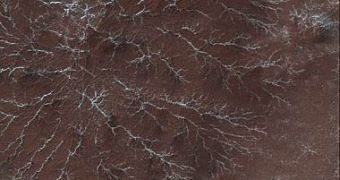Similar to its sister planet Earth, Mars has a season change, which depends on the position it occupies on its orbit, and a clime caused by the tilt the planet presented in relation to the Sun. During the southern winter, the north pole is tilted more towards the Sun, thus the south pole receives less light and cools to a temperature of less than minus 130 degrees Celsius, condensating the carbon dioxide gas from the atmosphere into a thin polar ice cap.
As the winter closes to an end, the growing sunlight is filtrated through the ice and reaches the red soil beneath it, heating it up in the process. This triggers a sublimation process of the ice in contact with the soil, fact that determines a build up in carbon dioxide vapor pressure, which will be released when the gas will find a weak spot to penetrate the ice and escape into Mars' atmosphere.
These carbon dioxide emissions sculpt intricate patterns in the Martian surface, creating some of the weirdest structures ever seen in Mars' landscape. Scientists involved in the study of the Red Planet's surface named these structures 'spiders' and 'lizard skin', and until now there have been no theories available to describe the process which formed them.
It seems that as the carbon dioxide gas outbursts back into the atmosphere, it also carries some of the dust present in the vicinity of these cracks in the ice. Though the process has not actually been observed while taking place, this is a possible explanation for the weird structures, as the ejected dioxide gas condenses back on top of the ice into so-called 'fans' patterns.
However, the shapes of these patterns still remain a mystery; they might be due to the geography of the land that lyes under the surface of the ice layer, which can reach a thickness of about 32 centimeters. They are scattered all around the top layer of the ice cap and increase the activity every spring, which will eventually evaporate all the ice material, as the summer draws to an end.
The data has been gathered by NASA's Mars Reconnaissance Orbiter and has been detailed in the American Geophysical Union meeting, which took place yesterday.

 14 DAY TRIAL //
14 DAY TRIAL // 
